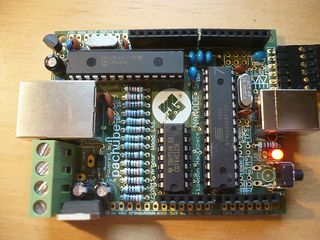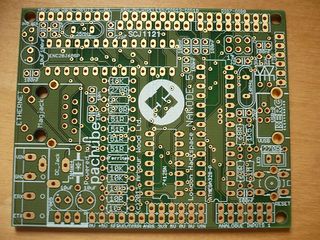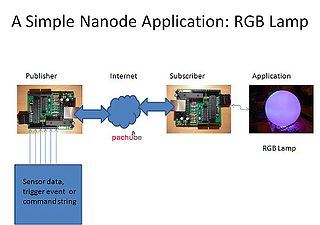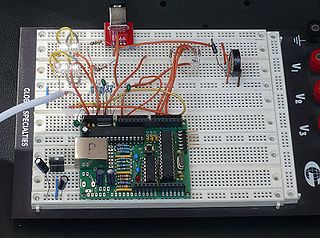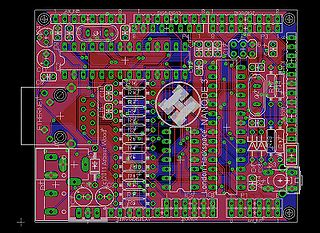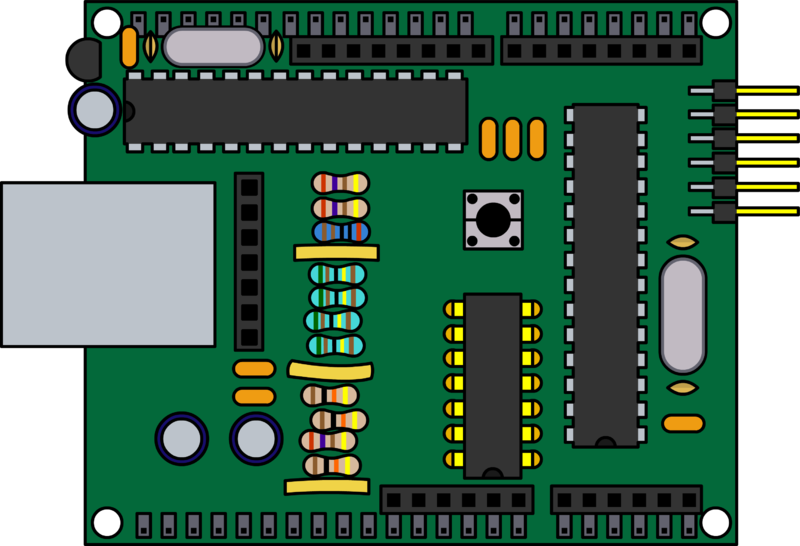Project:Nanode: Difference between revisions
No edit summary |
No edit summary |
||
| Line 36: | Line 36: | ||
'''Suggestions''' - Got an idea that needs help or hardware? [[Project:Nanode/Skunk Works | Skunk Works]] page. | '''Suggestions''' - Got an idea that needs help or hardware? [[Project:Nanode/Skunk Works | Skunk Works]] page. | ||
'''Documentation''' PCB Files, schematics and other useful pdf [http://wiki.hackspace.org.uk/wiki/Project:Nanode/docs Documents] | |||
'''Please Note''' In the interests of keeping the price down Nanode does not have the FTDI serial/USB chip on board - and in this respect it is like the Arduino Pro and Pro Mini. You will need a FTDI cable or adaptor board in order to get full functionality from Nanode. These can be bought cheaply from [http://www.ebay.co.uk/itm/USB-TTL-Serial-Cable-FTDI-chipset-/290576368332?pt=UK_Computing_CablesConnectors_RL&hash=item43a7b382cc Ebay] Make sure you buy the 5V version. | '''Please Note''' In the interests of keeping the price down Nanode does not have the FTDI serial/USB chip on board - and in this respect it is like the Arduino Pro and Pro Mini. You will need a FTDI cable or adaptor board in order to get full functionality from Nanode. These can be bought cheaply from [http://www.ebay.co.uk/itm/USB-TTL-Serial-Cable-FTDI-chipset-/290576368332?pt=UK_Computing_CablesConnectors_RL&hash=item43a7b382cc Ebay] Make sure you buy the 5V version. | ||
Revision as of 07:40, 7 July 2011
Nanode is a low cost, web connected, physical computing platform based on the same technology as Arduino.
A simple one board solution to getting projects on the web, build it as a DIY kit for about £20
London Hackspace - Home of the 'Nanode Project'
A collaborative venture in open source hardware and firmware.
Quick Links Getting you there faster
Buy One - contact ken dot boak at gmail dot com or @Monsonite on Twitter
Homepage - The Nanode homepage is at nanode.eu.
Nanode IRC Channel - Follow the Nanode Project on #nanode IRC on Freenode.
Special Nanode Users Group - Keep up to date with what other users are doing SNUG
IRC Archive - An archive of the #nanode IRC is maintained here Nanode back-log courtesy of Peitolm
Building It - this shortcut takes you to the Pictorial Building Guide
Applications Here's a list of Applications currently under development on the Nanode
FAQ Here's a list of Frequently Asked Questions about the Nanode
QSG A Quick Start Guide to get you up and running quickly with Nanode
Registration - Add your newly built Nanode to the Registrar of Nanodes and Users
Bitlash - Porting a simple interpreted language to configure and control Nanodes remotely online Bitlash
Suggestions - Got an idea that needs help or hardware? Skunk Works page.
Documentation PCB Files, schematics and other useful pdf Documents
Please Note In the interests of keeping the price down Nanode does not have the FTDI serial/USB chip on board - and in this respect it is like the Arduino Pro and Pro Mini. You will need a FTDI cable or adaptor board in order to get full functionality from Nanode. These can be bought cheaply from Ebay Make sure you buy the 5V version.
About Nanode
Nanode - a 30 second pitch
Nanode is an open source Arduino-like board that has in-built web connectivity. It connects to a range of wireless, wired and ethernet interfaces.
It allows you to develop web based sensor and control systems - giving you web access to six analogue sensor lines and six digital I/O lines.
It costs under £20 as an easy build it yourself kit. Nanode was designed with Hacking in mind.
Some Background
The Nanode is a low cost entry device aimed at network and Internet Connectivity projects.
Its name was originally derived from "Networked Arduino Node" as it essentially opens up the possibility of networking Arduino-like devices both to the internet, and locally using a mix of wired and wireless networks.
It has been conceived as an experimental platform, an enabling technology, which will allow applications to be developed at minimum cost and hassle.
It combines the functionality of the Arduino and an ethernet shield onto the one small board. This literally halves the cost of a net connected Arduino platform.
It has been designed with low cost hacking in mind and can be built easily for under £20 - so that it will appeal to those on a tight budget.
It uses the popular Arduino environment so will be familiar to many. It also accepts Arduino shields, and a wireless shield based on the popular RFM12 device is planned. This will open up the Nanode to wireless networking and creating bridges between wireless, and wired networks and the Internet.
Nanode consists of a small PCB which has the ATmega328 microcontroller, some glue logic, the ENC28J60 ethernet controller and a Magjack ethernet connector. The board only uses through-hole and DIL conventional components - so that it can be easily assembled by anyone who has basic soldering skills.
It makes an ideal project for a teaching workshop on web connectivity, and as such will appeal to Hackspaces for advanced Arduino workshops.
Nanode Applications
Nanode uses a Ethernet code library developed by Andrew Lindsay. Andrew has provided examples for a Twitter Client (using supertweet.net), a Pachube Publisher and Pachube Subscriber. Andrew has also developed code to allow DNS Client queries and sending UDP packet to a local network.
Nanode can be used as a micro web-server for simple home automation and control, be used to build web connected sensor networks and many other web connected applications.
For those wanting to tinker with M2M applications, two Nanodes can communicate data or commands via a web data service such as Pachube.
Another unique feature is that several Nanodes can be connected together on a multidrop serial bus and used for distributed control tasks, such as energy montoring or home automation.
The wired network supplies communications and power and can be made from low cost 4 core telephone cable. 12V power can be distributed around this network and used to drive relays and actuators such as door locks.
Nanode provides between 10 and 12 input/output lines of which 6 can be analogue inputs for sensors such as thermistors or used for voltage and current measurement. Three of the outputs can be used for PWM control of motors, RGB lamps etc. Radio control servos are easily interfaced to the Nanode.
Individual Nanodes can communicate via this network back to an ethernet connected "Master" unit. With RS485 driver ICs, the Nanode can be adapted as a DMX lighting controller, MIDI network or other serial control system.
Nanode features an extra row of I/O pins - compared to the standard Arduino. This row of pins can be plugged directly into a breadboard and brings all of the ATmega I/O pins and power onto the breadboard. This greatly simplifies prototyping new applications on breadboard.
By removing the ethernet controller and Magjack, it becomes a very low cost Arduino "work-alike".
Nanode was inspired by the work of several key contributors.
Tuxgraphics - who wrote the original ENC28J60 code library
JeeNodes - for all things small and node like and routines for the RFM12 wireless
Ciseco - for the idea of stringing nodes together with a simple protocol
And many others, whose work has contributed to this project.
Nanode is an Open Source Project.
Open Source Collaborative Projects
The Nanode is possibly the first open source collaborative hardware design project at the London Hackspace- conceived, designed, manufactured and coded by Hackspace members - for Hackspace members. As an exercise in the design and building of a simple but useful microcontroller product, Nanode will introduce minimum cost web connectivity.
London Hackspace Custom Nanode
Here's a first draft of the proposed custom Nanode for the Hackspace. The Big H logo is a bit wonky, but we should be able to correct that with a bitmap import. Roger Light is working on this and other minor layout tweaks.
This new board offers several improvements over the first prototype.
The reset switch is vertically mounted on the edge of the board - so it can be pressed even though there may be a shield fitted.
The LED - again on the board edge, is visible with a shield fitted.
The local serial bus is now a 4 way screw terminal block for very easy hooking up with 4 way telephone cable which supplies 12V power and the Rx/Tx and ground lines. Remote nodes could draw up to 500mA total at 12V for powering actuators, motors etc.
Auto reset now added from serial interface - this uses Pin 6 of the FTDI cable and works with Arduino IDE.
Virtual USB Added. Vusb USB is done in firmware negating the need for a £15 FTDI cable. We then use the same programming tool as Metaboard uses - cool.
News
Moved to Project:Nanode/News.
How to Build a Nanode
Building a Nanode
The complete step by step build sequence is here Building a Nanode.
An older version for a previous design can be found on my blog
Parts List
This section needs updating to reflect the changes in Nanode 5 over the earlier prototype.
All parts are readily available. I recommend Cool Components in South London for several of the key items. Interested parties should try to pool component purchasing to access volume discounts.
* 1 ATmega328 microcontroller (with Arduino bootloader) - CoolComponents £5.00 (£2.81 without bootloader) * 1 ENC28J60 ethernet controller - CoolComponents 1.99 * 1 Magjack - CoolComponents £1.99
The remaining parts were found to be considerably cheaper from Rapid Electronics giving a kit cost of £18 if parts are purchased in 10 off. This includes all parts, pcb, shipping and VAT.
* 1 74AHC125 quad buffer 174-9617 * 1 16MHz crystal 161-1761 * 1 25MHz crystal 161-1783 * 4 22pF ceramic capacitors 114-1760 * 8 100nF ceramic capacitors 121-6444 * 2 10nF ceramic capacitors 121-6435 * 3 10uF electrolytic capacitors 945-1056 * 1 7805 5V regulator 156-4483 * 1 78L33 3V3 regulator 146-7768 * 1 2K resistor 934-1480 * 4 51ohm 1% resistors 934-3342 * 3 270 ohm resistors 933-9353 * 3 10K resistors 933-9060 * 1 tact switch 181-3689 * 2 8 way 0.1" SIL Sockets * 2 6 way 0.1" SIL Sockets * 1 6 way 0.1" right angle header * 1 2.1mm dc jack socket * 1 1N4001 diode * 1 3mm LED * 2 32 pin 0.1" header strips (for optional I/O connectors).
You will also need:
* 1 Nanode pcb - available shortly to Hackspace members * 1 FTDI USB-serial cable - becoming a standard bit of kit for talking to microcontrollers. * or similar USB to serial converter such as Sparkfun/Cool Components * 1 CAT5 network cable to connect to router
Board Layout and Connectors
The nanode is, in essence, an arduino, with a hardwired ethernet chip, and several extra connectors / footprints for other useful bits and bobs.
It can do virtually anything an Arduino can do - in fact a part populated board is virtually half the cost of a cheap Arduino.
It has other features which we will slowly try to get sensibly documented here:
Pin Outs
| atmega328 pin | arduino name | other connections |
|---|---|---|
| 2 | D0 | ftdi rx, (ExtRx - only if tristate buffer is enabled by jumpered Dig 4 LOW) |
| 3 | D1 | ftdi tx, (ExtTx - only if tristate buffer is enabled by Dig 6 LOW) |
| 4 | D2 | ethernet and wireless RFM12B interrupt (INT 0) via trisate buffer/level shifter |
| 5 | D3 | USB D+ (And INT 1 from Vusb) |
| 6 | D4 | USB D- |
| 11 | D5 | (free) |
| 12 | D6 | etx enable / red LED LED comes on when LOW and this 'node is accessing the local bus |
| 13 | D7 | MAC address SCIO |
| 14 | D8 | effectively, slave select for the ethernet (ENC28J60 /CS) |
| 15 | D9 | IC7 slave select (if installed) |
| 16 | D10 | external wireless slave select |
| 17 | D11 | MOSI for all peripherals |
| 18 | D12 | MISO for all peripherals |
| 19 | D13 | SCK for all peripherals |
Other Main Features
Ethernet Connection
The two single-colour LEDs on the ethernet connector aren't connected directly to the Nanode; they are controlled from the ENC28J60 ethernet chip. However, you can set them to any arbitrary values you wish using the ethernet controller's registers.
(The schematic shows a single-colour LED and a dual-colour LED; this is a terribly minor bug in the schematic; the actual jack has two single-colour LEDs.)
Local Bus
The "local bus" communications are on the etx and erx screw terminals in the lower-left corner of the board. The lower terminal is etx (the labels are invisible once the board has been soldered together). When D9 is *low*, the output from D1 goes to both the FTDI cable connector and the etx terminal. Similarly, the input from both the ftdi cable and the erx pin comes in on D1 if the /RXEN pin is *low*. (Obviously, using both at once will be very confusing.) Note that /RXEN is not wired to the Nanode; it's recommended that you put a jumper between D4 and the /RXEN pin if you want to use the local bus. Contrarywise, you could just jumper it to GND if you don't want to use the FTDI connector, or if you can handle bus arbitration on a higher level... there's more then one way to do it.
The screw terminal connector can be used to connect Nanodes to the local wired serial bus. Using cheap 4 core phone cable, carry +12V, 0V, ExtTx, ExtRx, and connect many Nanodes together in a wired network. Standard phone cable will easily carry 500mA at 12V, so this bus can be used to power actuators such as relays, servos, door latches, displays and any other stuff that needs low power DC.
A slave Nanode does not need its Magjack or ethernet controller - so this saves about £4 in build cost and frees up the SPI bus as useful digital I/O.
Wireless Port
This version 5 Nanode has been designed to take a low cost RFM12 wireless transceiver breakout board from JeeLabs, which plugs directly into an 8 pin SIL socket in the middle of the top edge of the pcb. This can either be 433 or 868MHz. It runs on 3V3 and all code is compatible with the JeeLabs code.
Vusb Port
Vusb was devised by Metalab in Vienna to make a very low cost way of programming Arduino like devices and AVR processors. It runs a virtual USB client in the bootloader firmware allowing you to program the board with just a USB lead and no FTDI device. This is now working and can be used to load arduino sketches (Artag). Some additional polish is needed.
MAC Chip
The Microchip 11AA02E42 is a 256 byte EEprom which contains a unique MAC address and the rest of the array is free for user storage - such as configuration data. These chips are available up to 4K byte - and could be used for holding web pages, or bitlash scripts as a non-volatile extension to the internal EEprom. Needs special driver code to access - still under development (as of 7/6/11)
SPI Memory
An uncommitted SPI memory which can be SRAM, FRAM or dataflash/EEprom. I have used a 23K256 32K x 8 SRAM here - and can read it at approximately 100,000 bytes per second. Using this particular SRAM needs the whole board to be powered at 3V3 - which is a minor modification involving invasive surgery.
Servo Port
+5V, 0V and Digital 4 brought out on 3 adjacent pins for conveniently driving a single model servo.
Can also drive the "Modern Device" serial LCD display controller boards via a 3 wire servo cable.
Arduino Shield Connectors
Perversely Pitched to accecpt most Arduino shields. Watch out what you/they do with digital 8 and digital 10 or your ethernet may not work. Also you may have to use "extended headers" to raise the shield clear of the magjack and 7805 regulator metal work
Board Layout
Matt Gaffen has offered to do another really nice Nanode graphic to go here to show where all these connections are.
Connectors
Nanode is not short of connectors. As well as the Arduino shield connectors it has its own set aimed at different features
With the magjack on the left, these ports are along the top edge of the pcb. You can fit a single 0.1" header (or extended headers) and insert all of the useful Nanode I/O directly into a bread board.
Analogue 2 Connector (from left to right)
Pin Name
- +5V
- Analog Input 5
- Analog Input 4
- Analog Input 3 | This is the same analogue port lines brought to the top edge of board with +5V and 0V for convenience
- Analog Input 2
- Analog Input 1
- Analog Input 0
- OV
Wireless& SPI Connector - accepts a Jeelabs RFM12 breakout board directly. (from left to right)
Pin Name
- +5V
- 0V
- SCK
- MISO
- MOSI
- SS (digital 10 in this case)
- INT
- 3V3
Digital 7- 0 Connector (from left to right)
Pin Name
- Digital 7 |
- Digital 6 |
- Digital 5 |
- Digital 4 | Just Like Arduino "Digitals"
- Digital 3 |
- Digital 2 |
- Digital 1 |
- Digital 0 |
Then for the bottom row of connections - starting at the 7805 regulator and working left to right
- 0V
- +5V
- Digital 4 (Use this and 0V, +5V (above) to plug a 3 pin servo cable straight in
- /RxEN - jumper this to Digital 4 if you want to use the local serial bus instead of FTDI cable
- ETx - External Tx - buffered by 74125 tristate buffer and only enabled if Digital 6 is LOW
- ERx - External Rx - buffered by 74125 tristate buffer and only enabled if /RxEN (jumper it to Digital 4) is LOW
- /RESET |
- +3V3 |
- +5V | These 6 are just like Arduino "Power" connector
- 0V |
- 0V |
- Vin (+12V to 7805 regulator) |
- (Then there is a gap here)
- Analogue Input 0 |
- Analogue Input 1 |
- Analogue Input 2 | These 6 are just like Arduino "Analogs" connector
- Analogue Input 3 |
- Analogue Input 4 |
- Analogue Input 5 |
Power
The +ve is the screwterm closest to the magjack, and the 0V is next to it.
The 5V reg is rated at 1A so should be enough for small motors.
Current Build Files
The latest Nanode 5 build files have been put up on Thingiverse .
Earlier versions on Thingiverse are really for reference only and should not be treated as current.
Example Applications
Nanode Applications
Now moved to the Nanode Applications page.
Projects "In the Wild"
- Nanode controlled RGB LED Lamp, with simple serial command interpreter - see my blog here.
- 6 channel temperature monitoring using Pachube - email Ken via LHS list for code.
- Nanodes and MQTT will from the back bone of the Hackspace Instrumentation at Nottingham Hackspace. The first part of the system will be Gatekeeper our RFID door acces control system. (Sorry the wiki docs need a lot of work)
Add links to your own projects...
Brainstorming - Have your Ideas Adopted into Future Nanodes
June 11th - an all new Skunk Works page.
This is your chance to influence the evolution of the Nanode Project.
There will be a small budget available to support the best ideas and a prize competition for the best improvements upgrades and applications.
The aim is to continually upgrade and improve the basic Nanode - perhaps every 3 months or so with a new pcb.
We want to enhance the feature set and yet keep the price down to below the magic £20.
Put all your ideas on the Skunk Works page and we will make sure some of them become a reality.
Help and Further Documentation
Questions & Answers, Feedback
If you have any queries - please put them here under the relevant section heading.
Recent Q&A
...
Hardware
Before I wade through the wiki page, how come the nanode doesn't have an ftdi chip? solexious
Adding a FT23RL to the design would have added at least £3.25 to the cost (100 off) and as has been stated it is a surface mount device which the majority of assemblers would lack confidence in fitting to the board. One of the key features of the Nanode design is that anyone can put it together without specialist solderiing skills, moving to SMT devices would make it non-viable for DIY assembly.
As the board is fairly tight for real-estate it would have been difficult to find room for one.
It was assumed that the Nanode would be deployed into control and monitoring systems into which only occasional access to the UART would be required from a laptop - so a FTDI lead was deemed to be sufficient.
The FTDI lead is way over-priced, so the intention is to produce a ready built FTDI programming dongle for about half the cost of a FTDI lead.
Is the local bandwidth between two nanodes enough to create an ethernet bridge in software? -- Answer to myself: the multidrop bus is in the range of 9600 baud.
The ATmega328 is not limited to 9600 baud serial. If the distance between nodes is short then 115,200 baud may be possible. You could also connect nodes together with I2C or SPI over short distances. Ken
PCBs & Kits
Where can I order the Nanode? Can non-members join the PCB batch?
The first batch of 100 Nanodes has been sold out, we're currently preparing another batch for late June 2011. Bare boards may be available at a later date, but for now the £18 kit is the only option being offered. A small donation to the Hackspace from non-members would be appreciated. Ken
Bootloader Features
Will the Vusb code fit in the bootloader to allow its use for programming the board ?
By all accounts, adding Vusb will make the Nanode appear like a Metaboard - which can be programmed by adding their programmer to the toolsuite in the Arduino IDE. Programming should then be a case of picking the Metaboard option. Metaboard Ken.
Today's build of the loader is 1994 bytes long out of a possible 2048. It may be possible to add a few minor features.--Artag 22:47, 8 June 2011 (UTC)
Code Examples
There's a 'readpachube' example in Andrew's 1.6 software release, which I presume is the Pachube subscriber. I can't see a publisher though - is that available from somewhere else ? Trystan: I've created a load of client/publisher examples here: github
I have developed a Pachube Publisher and matching Subscriber which allows serial CSV text strings to be sent from one Nanode to another via my Pachube Feeds 9675. If you put a request email to the Hackspace mailing list,I will send you the files. You will need to add your own Pachube API Key. I've more detail on my blog here. Ken
